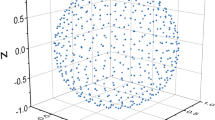Abstract
Conformational polymorphs are identical molecules that crystallize in different spatial formations. Understanding the amount of difference between the polymorphs might aid drug design as there is a widespread assumption that there exists a direct connection between the conformations in the crystallized form of the molecule and the conformations in the solvent.
We define a measure of similarity between conformational polymorphs and present an algorithm to compute it. For this end we weave together in a novel way our graph isomorphism method and substructure matching. We tested our algorithm on conformational polymorphs from the Cambridge Structural Database. Our experiments show that our method is very efficient in practice and has already yielded an important insight on the polymorphs stored in the data base.
K. Kedem was supported by NSF CISE Research Infrastructure grant #EIA- 9972853, by NSF #CCR-9988519, and by a grant from the Israeli Defence Ministry.
Access this chapter
Tax calculation will be finalised at checkout
Purchases are for personal use only
Preview
Unable to display preview. Download preview PDF.
Similar content being viewed by others
References
H.G. Barrow and R.M. Burstall, “Subgraph isomorphism, matching relational structures and maximal cliques”, Information Processing Letters, 4:83–84, 1976.
J. Bernstein, “Conformational polymorphism”, Chapter 13 in Organic solid-state Chemistry, G. Desiraju, ed. from Studies in Organic Chemistry, Elsevier, Amsterdam Vol 32, 1987.
J. Bernstein, R.E. Davis, L. Shimoni, N.L. Chang, “Patterns in hydrogen bonding: functionality and graph set analysis in crystals”, Angew. Chem. Int. Ed. Engl. 34:1555–1573, 1995.
R. Blom and A. Haaland, J. Mol. Struc. 128:21–27, 1985.
T.H. Cormen, C. E. Leiserson and R. L. Rivest, “Introduction to algorithms”, The MIT press, Cambridge, 1990.
J.D. Dunitz and J. Bernstein, “Disappearing polymorphs”, Accounts of Chemical Research, 28:193–200 1995.
J.P. Doucet and J. Weber, Computer-aided molecular design: Theory and applications, Academic Press 1996.
A. Enosh, “Determining similarity of conformational polymorphs”, M.SC. thesis, Computer Science Department, Ben-Gurion University, Israel.
S. Fortin. “The graph isomorphism problem”, Technical Report University of Alberta, 96–20 1996.
L.R. Foulds, Graph theory applications, Springer 1992.
P. Finn, D. Halperin, L. Kavraki, J. Latombe, R. Motwani, C. Shelton, and S. Venkatsubramanian, “Geometric manipulation of flexible ligands”, Applied Computational Geometry: Towards Geometric Engineering, LNCS 1148:67–78. Springer-Verlag, 1996.
D. Fischer, R. Nussinov and H. J. Wolfson, “3-D substructure matching in protein molecules”, In Proc. 3rd. Annual Symposium on Combinatorial Pattern Matching, Tucson, Arizona, USA. LNCS 644:136–150. Springer-Verlag, 1992.
J. E. Hopcroft and R.E. Tarjan, “Isomorphism of planar graphs”, Complexity of Computer Computation, R. E. Miller and J.W. Thatcher, editors, Plenum, New York, 131–152, 1972.
A.M. Lesk, “Detection of 3-D patterns of atoms in chemical structures”, Communications of ACM, 22:219–224, 1979.
E.M. Luks, “Isomorphism of graphs of bounded valence can be tested in polynomial time”, Journal of Computer and System Sciences, 25:42–65, 1982.
G. L. Miller, “Isomorphism of k-contractible graphs. A generalization of bounded valence and bounded genus”, Information and Control, 56:1–20, 1983.
H. J. Wolfson and I. Rigoutsos, “Geometric hashing”, IEEE Computational Science and Engineering, 4(4):10–21, 1997.
K. Yamazaki, H. L. Bodlaender, B. Fluiter and D. M. Thilikos, “Isomorphism for graphs of bounded distance width”, Algorithmica, 24(2):105–127, 1999.
Author information
Authors and Affiliations
Editor information
Editors and Affiliations
Rights and permissions
Copyright information
© 2002 Springer-Verlag Berlin Heidelberg
About this paper
Cite this paper
Enosh, A., Kedem, K., Bernstein, J. (2002). Determining Similarity of Conformational Polymorphs. In: Möhring, R., Raman, R. (eds) Algorithms — ESA 2002. ESA 2002. Lecture Notes in Computer Science, vol 2461. Springer, Berlin, Heidelberg. https://doi.org/10.1007/3-540-45749-6_40
Download citation
DOI: https://doi.org/10.1007/3-540-45749-6_40
Published:
Publisher Name: Springer, Berlin, Heidelberg
Print ISBN: 978-3-540-44180-9
Online ISBN: 978-3-540-45749-7
eBook Packages: Springer Book Archive




